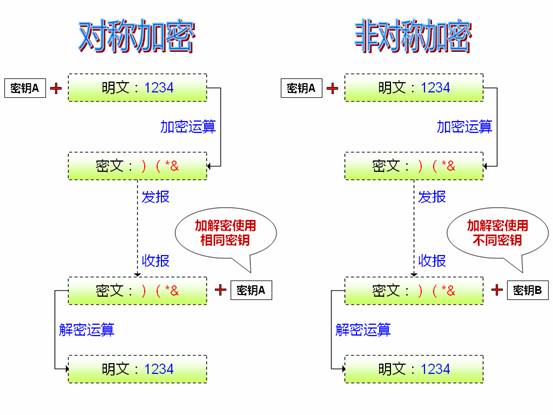JAVA加密算法实现用例 密钥一致协议
92660 理论 | 2014-12-27-
密钥一致协议是由公开密钥密码体制的奠基人 Diffie 和 Hellman 所提出的一种思想。
代表:指数密钥一致协议 (Exponential Key Agreement Protocol)
使用流程介绍:
甲方构建密钥对,将公钥公布给乙方,将私钥保留;双方约定数据加密算法;乙方通过甲方公钥构建密钥对,将公钥公布给甲方,将私钥保留。
甲方使用私钥、乙方公钥、约定数据加密算法构建本地密钥,然后通过本地密钥加密数据,发送给乙方加密后的数据;乙方使用私钥、甲方公钥、约定数据加密算法构建本地密钥,然后通过本地密钥对数据解密。
乙方使用私钥、甲方公钥、约定数据加密算法构建本地密钥,然后通过本地密钥加密数据,发送给甲方加密后的数据;甲方使用私钥、乙方公钥、约定数据加密算法构建本地密钥,然后通过本地密钥对数据解密。
不单单是甲乙双方两方,可以扩展为多方共享数据通讯,这样就完成了网络交互数据的安全通讯!package test; import java.security.KeyFactory; import java.security.KeyPair; import java.security.KeyPairGenerator; import java.security.PublicKey; import java.security.Security; import java.security.spec.X509EncodedKeySpec; import javax.crypto.Cipher; import javax.crypto.KeyAgreement; import javax.crypto.SecretKey; import javax.crypto.interfaces.DHPublicKey; import javax.crypto.spec.DHParameterSpec; public class DHKey { public static void main(String argv[]) { try { DHKey my = new DHKey(); my.run(); } catch (Exception e) { System.err.println(e); } } private void run() throws Exception { // A 构建密钥对,公钥给B Security.addProvider(new com.sun.crypto.provider.SunJCE()); KeyPairGenerator aliceKpairGen = KeyPairGenerator.getInstance("DH"); aliceKpairGen.initialize(512); KeyPair aliceKpair = aliceKpairGen.generateKeyPair(); byte[] alicePubKeyEnc = aliceKpair.getPublic().getEncoded(); // 公开密钥 // B 根据A的公钥构建自己的密钥对,同时把自己生成的公钥给A,通过A的公钥和自己的私钥构建DES的密钥 KeyFactory bobKeyFac = KeyFactory.getInstance("DH"); X509EncodedKeySpec x509KeySpec = new X509EncodedKeySpec(alicePubKeyEnc); PublicKey alicePubKey = bobKeyFac.generatePublic(x509KeySpec); DHParameterSpec dhParamSpec = ((DHPublicKey) alicePubKey).getParams(); KeyPairGenerator bobKpairGen = KeyPairGenerator.getInstance("DH"); bobKpairGen.initialize(dhParamSpec); KeyPair bobKpair = bobKpairGen.generateKeyPair(); KeyAgreement bobKeyAgree = KeyAgreement.getInstance("DH"); bobKeyAgree.init(bobKpair.getPrivate()); bobKeyAgree.doPhase(alicePubKey, true); SecretKey bobDesKey = bobKeyAgree.generateSecret("DES"); byte[] bobPubKeyEnc = bobKpair.getPublic().getEncoded(); // A 通过本地密钥和A的公钥构建DES密钥,这里还做一个验证 KeyFactory aliceKeyFac = KeyFactory.getInstance("DH"); x509KeySpec = new X509EncodedKeySpec(bobPubKeyEnc); PublicKey bobPubKey = aliceKeyFac.generatePublic(x509KeySpec); KeyAgreement aliceKeyAgree = KeyAgreement.getInstance("DH"); aliceKeyAgree.init(aliceKpair.getPrivate()); // 秘密密钥 aliceKeyAgree.doPhase(bobPubKey, true); SecretKey aliceDesKey = aliceKeyAgree.generateSecret("DES"); if (aliceDesKey.equals(bobDesKey)) System.out.println("A 和 B 的公钥 相同"); else System.out.println("A 和 B 的公钥 不同"); // B 通过密钥加密数据 Cipher bobCipher = Cipher.getInstance("DES"); bobCipher.init(Cipher.ENCRYPT_MODE, bobDesKey); String bobinfo = "这是B的机密信息"; System.out.println("B 加密前原文 :" + bobinfo); byte[] cleartext = bobinfo.getBytes(); byte[] ciphertext = bobCipher.doFinal(cleartext); // A 通过密钥解密数据 Cipher aliceCipher = Cipher.getInstance("DES"); aliceCipher.init(Cipher.DECRYPT_MODE, aliceDesKey); byte[] recovered = aliceCipher.doFinal(ciphertext); System.out.println("A解密 B 的信息 :" + (new String(recovered))); } } -
猜你喜欢
- 个人资料
-

Java小强
未曾清贫难成人,不经打击老天真。
自古英雄出炼狱,从来富贵入凡尘。
- 站内搜索
-
- 文章分类
- 最新文章
- 热门文章
发表评论: